GRAPHIC: gruesome post-injection skin diseases continue plaguing people all over the world
TheCOVIDBlog.com
April 30, 2023

The COVID Blog® shifted its focus from post-injection adverse reactions and deaths in 2021 to mostly just the deaths since 2022. The adverse reactions were far too innumerable to report representative samples thereof. Post-injection amputations, paralysis, and Shawn Skelton Syndrome trigger the most engagements herein and on other platforms.
A bit of positive news. Mr. Tim Berry is the British man who became paralyzed from the neck down after his Pfizer mRNA injection on January 7, 2022.
RELATED: Tim Berry: 30-year-old British man suffers severe post-Pfizer spinal cord deterioration, paralyzed from chest down three weeks after the injection (February 28, 2022)
It took almost a year. But he appears to be almost 100% back to normal.
Everyone has heard the idiomatic phrase “being comfortable in your own skin.” It means that you are confident in who and what you are. The phrase has literal meaning as well.
Skincare products comprise 42% of all cosmetics sales in the U.S., or about $21 billion in skincare product sales per year. Globally, people spend $240 billion per year on skincare. A 2017 Groupon survey found that the average American woman “who invests regularly in their appearance” spends $3,756 per year on their looks. For men, that number is $2,928 per year.
Granted Groupon users are mostly higher earners ($75,000-plus per year). But the higher your income and education, the stupider you are more likely you are to have received mRNA and/or viral vector DNA injections in the U.S.
A September 2021 Kaiser Family Foundation report found that 68% of Americans earning under $40,000 had received at least one injection, versus 79% of those earning $90,000-plus. College graduates had an 80% vaccination rate, versus 67% of Americans without college degrees. For the record, self-identified Democrats were 90% vaxxed at that point versus 58% of self-identified Republicans.
RELATED: Sarah Beuckmann: 34-year-old Scotland woman suffers gruesome AstraZeneca adverse reaction (April 24, 2021)
Skin is the largest organ in the human body. It also defines humans both socioeconomically and individually. Clear skin is the difference between being aesthetically beautiful and average (or ugly). Women of course spend a lot of money on skincare products. And these days, men are more concerned with and spending more money on their skin and faces. Bad skin actually leads to mental health issues.
A February 2020 survey by OnePoll and Massage Envy found that bad skin (67%) was second (narrowly) only to body shape and image (68%) as having a negative impact on self-confidence. More than half of respondents reported skipping work and dates because of acne and other bad skin issues. The most telling finding was that 58% of respondents said that they were sometimes too embarrassed by their skin to even visit a doctor. They did not want to be seen in public by anyone.
We’ve chronicled several post-injection skin disease cases on The COVID Blog®. But based on numerous case studies chronicled by scientists across the globe, post-injection skin conditions are happening far more often than we could possibly know about.
Iran: post-injection Sinopharm toxic epidermal necrosis
Researchers at Tehran University of Medical Sciences published their finding in the December 2022 issue of Clinical Case Reports. A 67-year-old man, with no prior history of skin disorders, received the Sinopharm “inactivated virus” injection six days prior to his visit to said researchers.
RELATED: Peru: young doctor dead three weeks after Sinopharm COVID-19 “vaccine” (March 29, 2021)
He suffered a high fever almost immediately after the injection, followed by “erythema patches on his back [and] bullous lesions on the lower extremities.” He also had elevated D-Dimer levels, but tested negative for deep vein thrombosis. By day seven, 30% of his body was covered with “purpuric and dusky patches…with flaccid bullae and areas of epidermal detachment.” He was diagnosed with toxic epidermal necrolysis.
Instead of translating the medical mumbo jumbo, here are the photos.
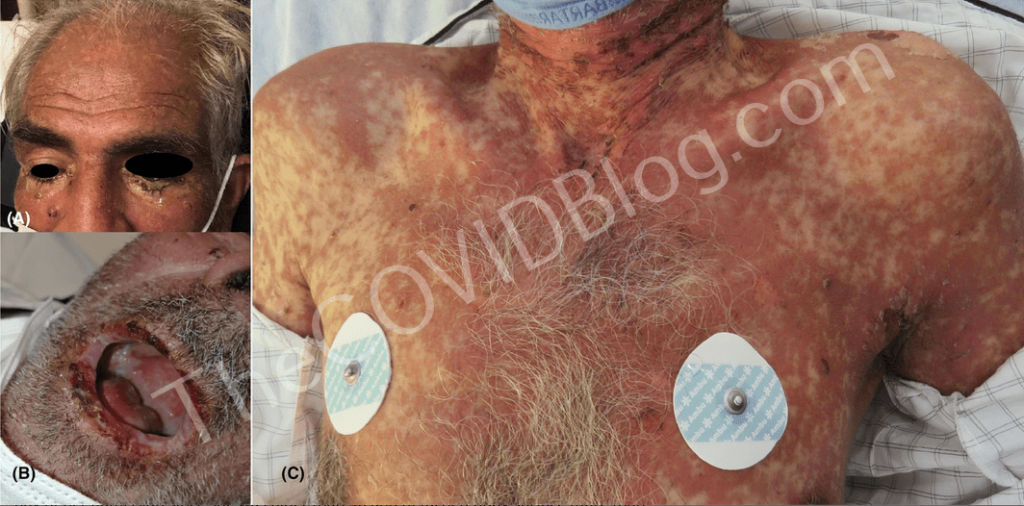
The patient was treated with organ transplant rejection medication and powerful corticosteroids. He was also treated for potential pink eye (conjunctivitis). The lesions cleared up after 14 days of treatment. Researchers concluded:
“It is highly suspected that the offending agent is the vaccine since other causes such as medications could not cause this phenomenon in the aforementioned timetable.”
Read the full case study here.
Philippines: gruesome Pfizer-induced bullous pemphigoid
Researchers at Rizal Medical Center in Manila published a case study in the March 2023 issue of the Journal of the European Academy of Dermatology and Venereology. A 62-year-old male patient with preexisting psoriasis received two AstraZeneca viral vector DNA injections in late 2021. He reported no apparent adverse reactions. The patient received a Pfizer mRNA booster shot in late November 2022.
Two days after the booster shot, the patient experienced “new onset tense blisters on the legs.” He also “developed a flare of psoriasis described as multiple erythematous plaques on the extremities” and “multiple pruritic tense vesicles and bullae, with erosions and serous crusting.” Researchers diagnosed him with a rare, coexistent bullous pemphigoid and psoriasis.
The photos are…
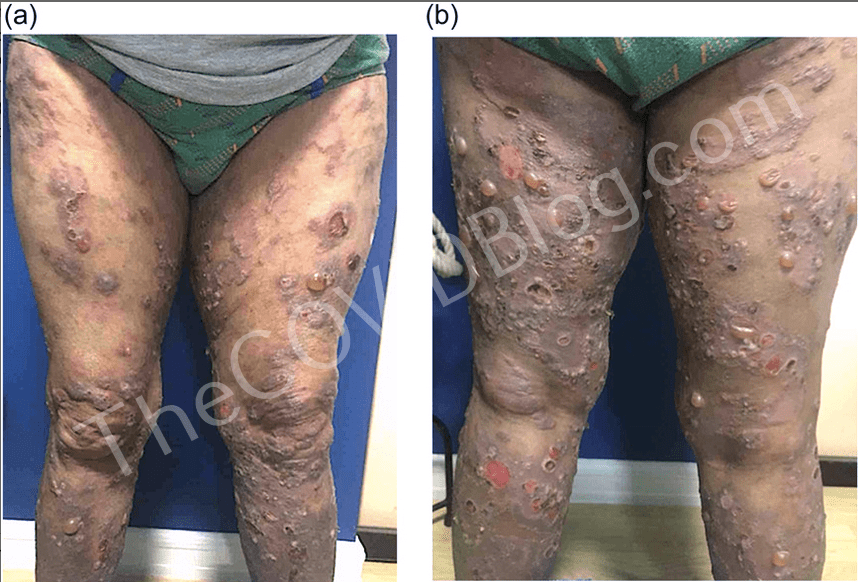
RELATED: Jane Stroud: British woman develops gruesome skin disorder after second AstraZeneca viral vector DNA injection (October 4, 2021)
It took a month of aggressive corticosteroids, methotrexate (a cancer drug), antihistamines and folic acid to clear the lesions. A three-month followup showed that the lesion were still clear, but the patient was permanently scarred.
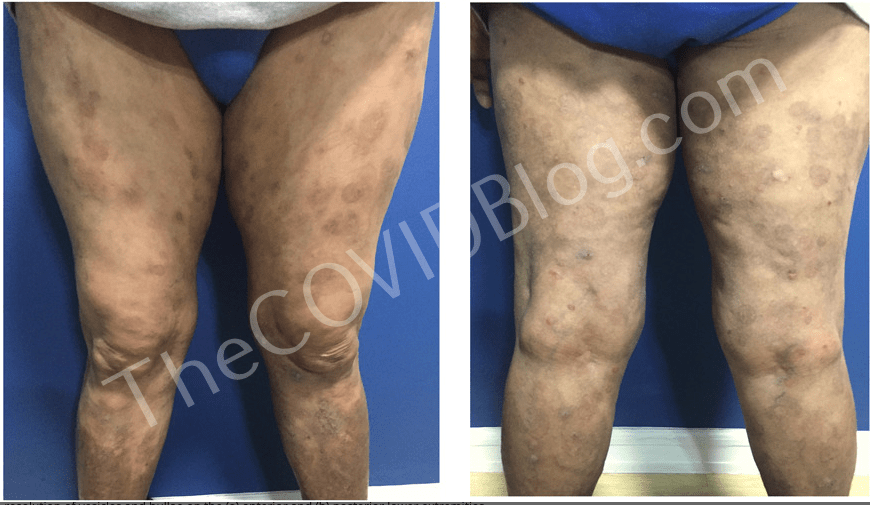
Researcher concluded:
“The association between BP and psoriasis is infrequent. Whether the development of BP in our patient is a coincidence or is triggered by COVID-19 vaccination is still difficult to elucidate at this time. Although a true association may exist between BP development and mRNA COVID-19 (Pfizer-BioNTech) vaccination, additional reports and studies are needed to prove their association.”
Read the full case study here.
Turkey: nine patients developed various skin diseases within 15 days after the injections
Researchers at Kastamonu University in Turkey published their findings in the February 2023 issue of the Journal of Cosmetic Dermatology. Nine patients (six males, three females; average age = 38) received either Sinovac CoronaVac “inactivated virus” (four patients) or Pfizer mRNA (five patients) injections between April 2021 and July 2021.
RELATED: Philippines officials: 24 deaths after Sinovac and AstraZeneca shots are “unrelated” (May 6, 2021)
The youngest patient, a 19-year-old male, suffered “localized erythema…with fixed drug eruption on the anterior side of the trunk” less than four hours after a Pfizer shot.
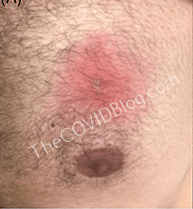
A 37-year-old female patient suffered acute urticaria (hives) less than 24 hours after a Pfizer shot.
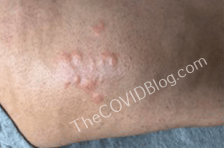
A 40-year-old male patient was diagnosed with a pityriasis rosea-like eruptions seven days after a Pfizer shot.
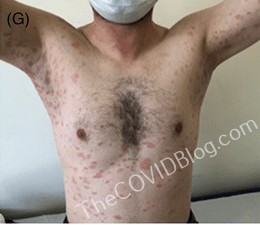
Patient #4, a 35-year-old male, was diagnosed with herpes simplex 48 hours after a Pfizer shot.
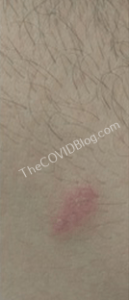
All of the CoronaVac adverse reactions occurred between the fifth and tenth days after the injections. Despite their findings, researchers encouraged everyone to receive as many doses of the injections as recommended by health authorities.
University of Michigan: two patients with cutaneous lymphoid infiltrates
Researchers published their findings in the March 2023 issue of the Journal of Cutaneous Pathology. Cutaneous lymphoid infiltrates are either benign or malignant (cancerous) in nature. They are difficult to diagnose and typically require several biopsies to ensure the lesions are noncancerous.
A 53-year-old man with a history of eczema was Patient #1 in the Michigan case reports. He suffered a “papulonodular eruption” less than one week after a Moderna mRNA injection. Despite the gruesome reaction, the patient received a second Moderna mRNA injection, which made matters worse. The condition spread all over his body after two weeks despite taking powerful oral corticosteroids. Antivirals, antibiotics and antihistamines were prescribed thereafter.
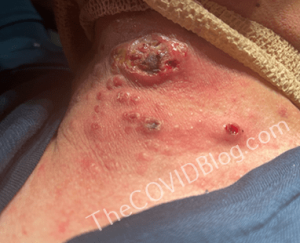
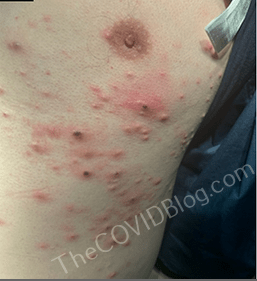
In typical United States fashion, researchers noted that “Positron emission tomography–computed tomography (PET/CT) was not performed because of lack of insurance coverage.” It took two months and several biopsies. But the lesions eventually cleared up. The patient, however, is permanently scarred.
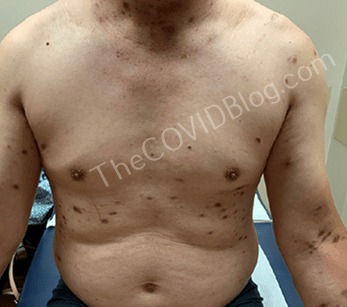
No photos were provided of the second patient. But the 62-year-old female developed “red, flat asymptomatic macules scattered on the bilateral arms” within a week after her second Pfizer mRNA injection. She was diagnosed with skin cancer after five biopsies. No outcome was reported. But the patient was considering a bone marrow transplant and chemotherapy to treat the cancer.
Researchers concluded that “lymphomatoid reactions as well as overt lymphoma may be temporally associated with COVID-19 vaccination and/or infection with SARS-CoV-2.”
California: young patient with post-injection Eosinophilic cellulitis
Researchers at the University of California, San Diego published their findings in May 2022 in the journal Pediatric Dermatology. A 12-year-old boy developed “seven arcuate and annular pink edematous plaques” just 24 hours after a Pfizer mRNA injection. The largest one was on his lower back.
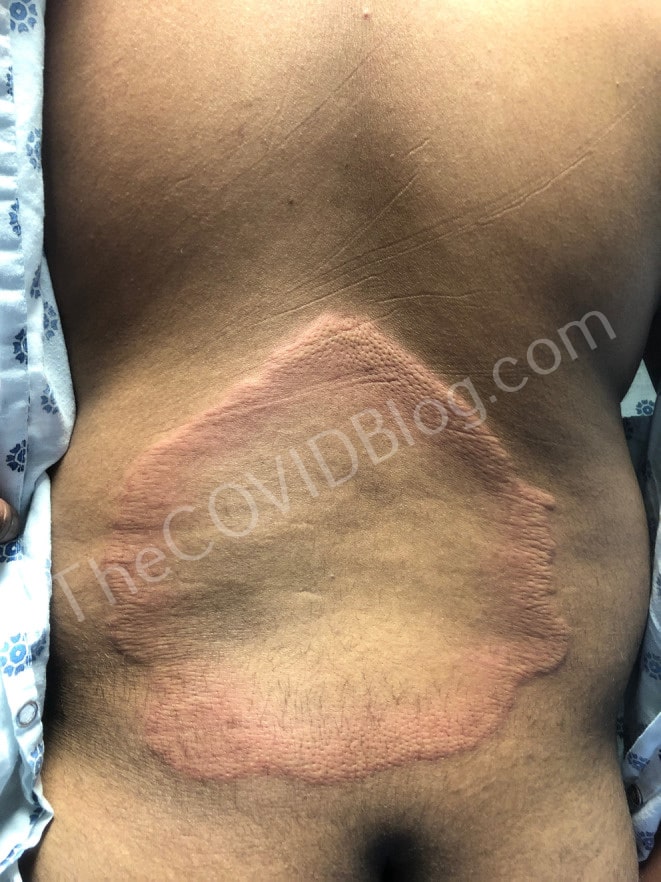
He was diagnosed with “urticarial dermatitis with tissue eosinophilia compatible with Wells syndrome.” The patient underwent a biopsy to ensure the condition was benign. Antihistamines and topical steroids resolved the issue after a month.
Researchers concluded:
“The only identifiable trigger in this case was the BNT162b2 COVID‐19 mRNA vaccine, administered one day prior to onset of the rash.”
Australia: 59 patients with autoimmune blistering skin diseases
Researchers at St. George Hospital in Sydney, New South Wales published their findings in January 2023 in the journal Frontiers in Medicine. Autoimmune blistering skin diseases (AIBD) are a class of disorders, including some of the foregoing cases. Aussie researchers identified 59 patients with AIBD from February 2021 to November 2022. The instant case study highlighted 11 of said cases that were “triggered by COVID-19 vaccination.”
The most severe case, after an AstraZeneca viral vector DNA injection, required six months of hospitalization just to get the condition somewhat under control.
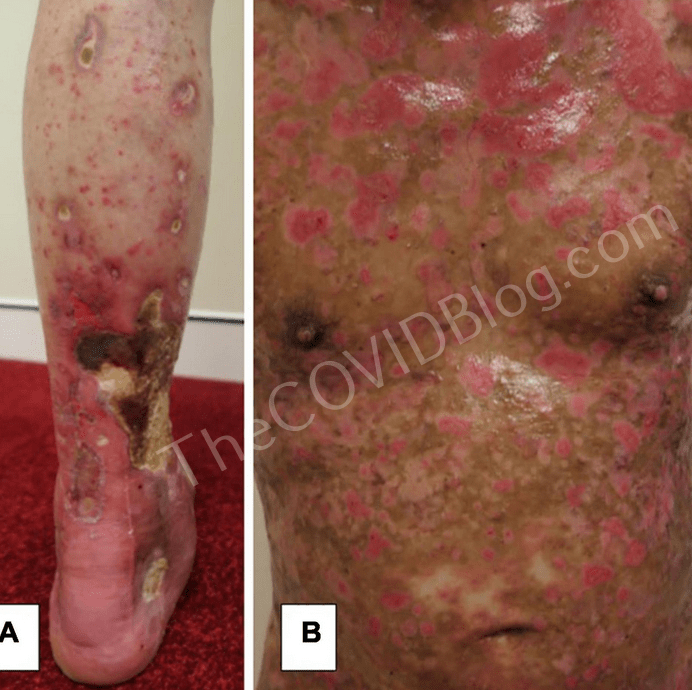
The case study does not make clear if the condition completely resolved. Another case, termed severe pemphigus vulgaris, looks to have rotted a woman’s fingernails completely away.
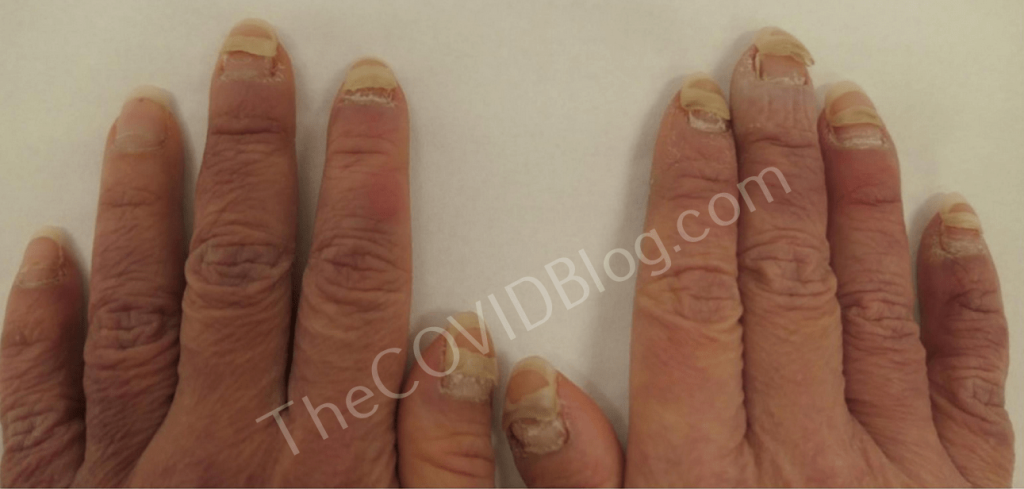
Researchers concluded:
“It is evident that COVID-19 vaccinations contribute to flares of AIBD as well as the induction of the disease. This evidence clarifies the importance of including a history of recent vaccinations, including COVID-19, in the assessment of patients with the new AIBD activity.”
Countless millions dead or suffering in silence
The most common reason for vaxxed-injured people to stay silent is the imminent backlashfrom family, friends, co-workers, and random online trolls. They do not want to be called “anti-vaxxer,” “conspiracy theorist,” etc.
Many vaxx-injured people try and go on with life as normal, pretending all is well until they physically cannot do so anymore. But if a few pimples cause people to miss work, just think of what’s going on with the untold millions of people suffering from gruesome, post-injection skin conditions.
The lethal injections kill people in various ways beyond actual death. Paralysis is essentially death for an otherwise healthy person who suddenly wakes up and cannot walk. We’ve chronicled cases of vaxx-injured individuals committing suicide because they could not accept their new realities and disabilities.
Further, the research suggests that most people are far too embarrassed to go to a doctor with these conditions. And if you live in the United States, you’ll need to be wealthy and lie about the cause of the condition in order to get any sort of treatment.
RELATED: Richard Terrell: 74-year-old Virginia man gets full-body swelling, severe rash after Johnson & Johnson shot (March 31, 2021)
This blogger has always understood that he cannot be “gorgeous” because of the port wine stain birthmark on the right side of his face. Beauty is typically equated with facial symmetry. It was a struggle as a child. But only boys needled about it. The girls liked the smile, the muscles, and the glasses – so the problem resolved itself in the teen years.
Skin and hair are the two features that define humans as individuals. That’s why hair loss treatment and skincare are multi-billion dollar industries. Numerous people have contacted The COVID Blog® hoping to find help with their post-injection alopecia (hair loss) and gruesome skin adverse reactions. You can literally sense the anxiety in said emails. Destroying someone’s hair and skin is tantamount to destroying the individual, especially women.
We’ll continue connecting those suffering from post-injection skin disorders with others who are suffering the same. But ultimately many of these conditions are of the autoimmune variety, i.e. permanent. You’ll have a chance at recovery if you can afford treatment (in the U.S.). Most of the foregoing cases resolved completely, and left scars. Those scars, however, are both physical and mental.
Stay vigilant and protect your friends and loved ones.


No comments:
Post a Comment